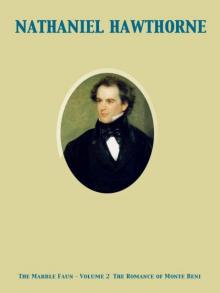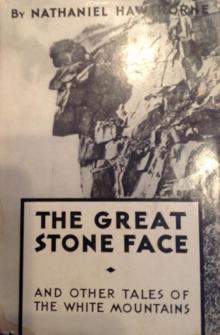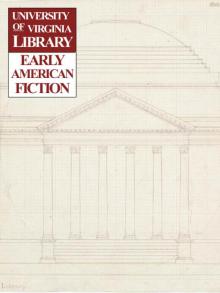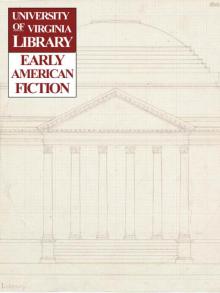- Home
- Nathaniel Hawthorne
The Marble Faun; Or, The Romance of Monte Beni - Volume 2
The Marble Faun; Or, The Romance of Monte Beni - Volume 2 Read online
Produced by Michael Pullen and David Widger
THE MARBLE FAUN,
or The Romance of Monte Beni
BY NATHANIEL HAWTHORNE
Volume II.
In Two Volumes
Contents:
Volume I
I MIRIAM, HILDA, KENYON, DONATELLO II THE FAUN III SUBTERRANEAN REMINISCENCES IV THE SPECTRE OF THE CATACOMB V MIRIAM'S STUDIO VI THE VIRGIN'S SHRINE VII BEATRICE VIII THE SUBURBAN VILLA IX THE FAUN AND NYMPH X THE SYLVAN DANCE XI FRAGMENTARY SENTENCES XII A STROLL ON THE PINCIAN XIII A SCULPTOR'S STUDIO XIV CLEOPATRA XV AN AESTHETIC COMPANY XVI A MOONLIGHT RAMBLE XVII MIRIAM'S TROUBLE XVIII ON THE EDGE OF A PRECIPICE XIX THE FAUN'S TRANSFORMATION XX THE BURIAL CHANT XXI THE DEAD CAPUCHIN XXII THE MEDICI GARDENS XXIII MIRIAM AND HILDA
Volume II
XXIV THE TOWER AMONG THE APENNINES XXV SUNSHINE XXVI THE PEDIGREE OF MONTE BENI XXVII MYTHS XXVIII THE OWL TOWER XXIX ON THE BATTLEMENTS XXX DONATELLO'S BUST XXXI THE MARBLE SALOON XXXII SCENES BY THE WAY XXXIII PICTURED WINDOWS XXXIV MARKET-DAY IN PERUGIA XXXV THE BRONZE PONTIFF'S BENEDICTION XXXVI HILDA'S TOWER XXXVII THE EMPTINESS OF PICTURE GALLERIES XXXVIII ALTARS AND INCENSE XXXIX THE WORLD'S CATHEDRAL XL HILDA AND A FRIEND XLI SNOWDROPS AND MAIDENLY DELIGHTS XLII REMINISCENCES OF MIRIAM XLIII THE EXTINCTION OF A LAMP XLIV THE DESERTED SHRINE XLV THE FLIGHT OF HILDA'S DOVES XLVI A WALK ON THE CAMPAGNA XLVII THE PEASANT AND CONTADINA XLVIII A SCENE IN THE CORSO XLIX A FROLIC OF THE CARNIVAL L MIRIAM, HILDA, KENYON, DONATELLO
THE MARBLE FAUN
Volume II
CHAPTER XXIV
THE TOWER AMONG THE APENNINES
It was in June that the sculptor, Kenyon, arrived on horseback at thegate of an ancient country house (which, from some of its features,might almost be called a castle) situated in a part of Tuscany somewhatremote from the ordinary track of tourists. Thither we must nowaccompany him, and endeavor to make our story flow onward, like astreamlet, past a gray tower that rises on the hillside, overlooking aspacious valley, which is set in the grand framework of the Apennines.
The sculptor had left Rome with the retreating tide of foreignresidents. For, as summer approaches, the Niobe of Nations is made tobewail anew, and doubtless with sincerity, the loss of that largepart of her population which she derives from other lands, and on whomdepends much of whatever remnant of prosperity she still enjoys. Rome,at this season, is pervaded and overhung with atmospheric terrors, andinsulated within a charmed and deadly circle. The crowd of wanderingtourists betake themselves to Switzerland, to the Rhine, or, from thiscentral home of the world, to their native homes in England or America,which they are apt thenceforward to look upon as provincial, afteronce having yielded to the spell of the Eternal City. The artist, whocontemplates an indefinite succession of winters in this home of art(though his first thought was merely to improve himself by a briefvisit), goes forth, in the summer time, to sketch scenery and costumeamong the Tuscan hills, and pour, if he can, the purple air of Italyover his canvas. He studies the old schools of art in the mountain townswhere they were born, and where they are still to be seen in the fadedfrescos of Giotto and Cimabue, on the walls of many a church, or inthe dark chapels, in which the sacristan draws aside the veil from atreasured picture of Perugino. Thence, the happy painter goes to walkthe long, bright galleries of Florence, or to steal glowing colors fromthe miraculous works, which he finds in a score of Venetian palaces.Such summers as these, spent amid whatever is exquisite in art, or wildand picturesque in nature, may not inadequately repay him for the chillneglect and disappointment through which he has probably languished, inhis Roman winter. This sunny, shadowy, breezy, wandering life, in whichhe seeks for beauty as his treasure, and gathers for his winter's honeywhat is but a passing fragrance to all other men, is worth living for,come afterwards what may. Even if he die unrecognized, the artist hashad his share of enjoyment and success.
Kenyon had seen, at a distance of many miles, the old villa or castletowards which his journey lay, looking from its height over a broadexpanse of valley. As he drew nearer, however, it had been hidden amongthe inequalities of the hillside, until the winding road brought himalmost to the iron gateway. The sculptor found this substantial barrierfastened with lock and bolt. There was no bell, nor other instrumentof sound; and, after summoning the invisible garrison with his voice,instead of a trumpet, he had leisure to take a glance at the exterior ofthe fortress.
About thirty yards within the gateway rose a square tower, loftyenough to be a very prominent object in the landscape, and more thansufficiently massive in proportion to its height. Its antiquity wasevidently such that, in a climate of more abundant moisture, the ivywould have mantled it from head to foot in a garment that might, by thistime, have been centuries old, though ever new. In the dry Italian air,however, Nature had only so far adopted this old pile of stonework as tocover almost every hand's-breadth of it with close-clinging lichensand yellow moss; and the immemorial growth of these kindly productionsrendered the general hue of the tower soft and venerable, and took awaythe aspect of nakedness which would have made its age drearier than now.
Up and down the height of the tower were scattered three or fourwindows, the lower ones grated with iron bars, the upper ones vacantboth of window frames and glass. Besides these larger openings, therewere several loopholes and little square apertures, which might besupposed to light the staircase, that doubtless climbed theinterior towards the battlemented and machicolated summit. With thislast-mentioned warlike garniture upon its stern old head and brow,the tower seemed evidently a stronghold of times long past. Many acrossbowman had shot his shafts from those windows and loop-holes, andfrom the vantage height of those gray battlements; many a flight ofarrows, too, had hit all round about the embrasures above, or theapertures below, where the helmet of a defender had momentarilyglimmered. On festal nights, moreover, a hundred lamps had often gleamedafar over the valley, suspended from the iron hooks that were ranged forthe purpose beneath the battlements and every window.
Connected with the tower, and extending behind it, there seemed to bea very spacious residence, chiefly of more modern date. It perhaps owedmuch of its fresher appearance, however, to a coat of stucco andyellow wash, which is a sort of renovation very much in vogue with theItalians. Kenyon noticed over a doorway, in the portion of the edificeimmediately adjacent to the tower, a cross, which, with a bell suspendedabove the roof, indicated that this was a consecrated precinct, and thechapel of the mansion.
Meanwhile, the hot sun so incommoded the unsheltered traveller, that heshouted forth another impatient summons. Happening, at the same moment,to look upward, he saw a figure leaning from an embrasure of thebattlements, and gazing down at him.
"Ho, Signore Count!" cried the sculptor, waving his straw hat, for herecognized the face, after a moment's doubt. "This is a warm reception,truly! Pray bid your porter let me in, before the sun shrivels me quiteinto a cinder."
"I will come myself," responded Donatello, flinging down his voice outof the clouds, as it were; "old Tomaso and old Stella are both asleep,no doubt, and the rest of the people are in the vineyard. But I haveexpected you, and you are welcome!"
The young Count--as perhaps we had better designate him in his ancestraltower--vanished from the battlements; and Kenyon saw his figurea
ppear successively at each of the windows, as he descended. On everyreappearance, he turned his face towards the sculptor and gave a nod andsmile; for a kindly impulse prompted him thus to assure his visitor of awelcome, after keeping him so long at an inhospitable threshold.
Kenyon, however (naturally and professionally expert at reading theexpression of the human countenance), had a vague sense that this wasnot the young friend whom he had known so familiarly in Rome; not thesylvan and untutored youth, whom Miriam, Hilda, and himself had liked,laughed at, and sported with; not the Donatello whose identity they hadso playfully mixed up with that of the Faun of Praxiteles.
Finally, when his host had emerged from a side portal of the mansion,and approached the gateway, the traveller still felt that there wassomething lost, or something gained (he hardly knew which), that set theDonatello of to-day irreconcilably at odds with him of yesterday. Hisvery gait showed it, in a certain gravity, a weight and measure of step,that had nothing in common with the irregular buoyancy which used todistinguish him. His face was paler and thinner, and the lips less fulland less apart.
"I have looked for you a long while," said Donatello; and, though hisvoice sounded differently, and cut out its words more sharply than hadbeen its wont, still there was a smile shining on his face, that, forthe moment, quite brought back the Faun. "I shall be more cheerful,perhaps, now that you have come. It is very solitary here."
"I have come slowly along, often lingering, often turning aside,"replied Kenyon; "for I found a great deal to interest me in themediaeval sculpture hidden away in the churches hereabouts. An artist,whether painter or sculptor, may be pardoned for loitering through sucha region. But what a fine old tower! Its tall front is like a page ofblack letter, taken from the history of the Italian republics."
"I know little or nothing of its history," said the Count, glancingupward at the battlements, where he had just been standing. "But I thankmy forefathers for building it so high. I like the windy summit betterthan the world below, and spend much of my time there, nowadays."
"It is a pity you are not a star-gazer," observed Kenyon, also lookingup. "It is higher than Galileo's tower, which I saw, a week or two ago,outside of the walls of Florence."
"A star-gazer? I am one," replied Donatello. "I sleep in the tower,and often watch very late on the battlements. There is a dismal oldstaircase to climb, however, before reaching the top, and a successionof dismal chambers, from story to story. Some of them were prisonchambers in times past, as old Tomaso will tell you."
The repugnance intimated in his tone at the idea of this gloomystaircase and these ghostly, dimly lighted rooms, reminded Kenyon of theoriginal Donatello, much more than his present custom of midnight vigilson the battlements.
"I shall be glad to share your watch," said the guest; "especially bymoonlight. The prospect of this broad valley must be very fine. But Iwas not aware, my friend, that these were your country habits. I havefancied you in a sort of Arcadian life, tasting rich figs, and squeezingthe juice out of the sunniest grapes, and sleeping soundly all night,after a day of simple pleasures."
"I may have known such a life, when I was younger," answered the Countgravely. "I am not a boy now. Time flies over us, but leaves its shadowbehind."
The sculptor could not but smile at the triteness of the remark, which,nevertheless, had a kind of originality as coming from Donatello. He hadthought it out from his own experience, and perhaps considered himselfas communicating a new truth to mankind.
They were now advancing up the courtyard; and the long extent of thevilla, with its iron-barred lower windows and balconied upper ones,became visible, stretching back towards a grove of trees.
"At some period of your family history," observed Kenyon, "the Countsof Monte Beni must have led a patriarchal life in this vast house. Agreat-grandsire and all his descendants might find ample verge here, andwith space, too, for each separate brood of little ones to play withinits own precincts. Is your present household a large one?"
"Only myself," answered Donatello, "and Tomaso, who has been butlersince my grandfather's time, and old Stella, who goes sweeping anddusting about the chambers, and Girolamo, the cook, who has but an idlelife of it. He shall send you up a chicken forthwith. But, first of all,I must summon one of the contadini from the farmhouse yonder, to takeyour horse to the stable."
Accordingly, the young Count shouted again, and with such effect that,after several repetitions of the outcry, an old gray woman protrudedher head and a broom-handle from a chamber window; the venerable butleremerged from a recess in the side of the house, where was a well, orreservoir, in which he had been cleansing a small wine cask; anda sunburnt contadino, in his shirt-sleeves, showed himself on theoutskirts of the vineyard, with some kind of a farming tool in hishand. Donatello found employment for all these retainers in providingaccommodation for his guest and steed, and then ushered the sculptorinto the vestibule of the house.
It was a square and lofty entrance-room, which, by the solidity of itsconstruction, might have been an Etruscan tomb, being paved and walledwith heavy blocks of stone, and vaulted almost as massively overhead.On two sides there were doors, opening into long suites of anteroomsand saloons; on the third side, a stone staircase of spacious breadth,ascending, by dignified degrees and with wide resting-places, to anotherfloor of similar extent. Through one of the doors, which was ajar,Kenyon beheld an almost interminable vista of apartments, opening onebeyond the other, and reminding him of the hundred rooms in Blue Beard'scastle, or the countless halls in some palace of the Arabian Nights.
It must have been a numerous family, indeed, that could ever havesufficed to people with human life so large an abode as this, and impartsocial warmth to such a wide world within doors. The sculptor confessedto himself, that Donatello could allege reason enough for growingmelancholy, having only his own personality to vivify it all.
"How a woman's face would brighten it up!" he ejaculated, not intendingto be overheard.
But, glancing at Donatello, he saw a stern and sorrowful look in hiseyes, which altered his youthful face as if it had seen thirty years oftrouble; and, at the same moment, old Stella showed herself through oneof the doorways, as the only representative of her sex at Monte Beni.

 The Scarlet Letter
The Scarlet Letter Young Goodman Brown : By Nathaniel Hawthorne - Illustrated
Young Goodman Brown : By Nathaniel Hawthorne - Illustrated The Birthmark
The Birthmark The Marble Faun; Or, The Romance of Monte Beni - Volume 1
The Marble Faun; Or, The Romance of Monte Beni - Volume 1 The Minister's Black Veil
The Minister's Black Veil The Great Stone Face, and Other Tales of the White Mountains
The Great Stone Face, and Other Tales of the White Mountains The House of the Seven Gables
The House of the Seven Gables The Snow Image
The Snow Image The Blithedale Romance
The Blithedale Romance Rappaccini's Daughter: By Nathaniel Hawthorne - Illustrated
Rappaccini's Daughter: By Nathaniel Hawthorne - Illustrated Twice-Told Tales
Twice-Told Tales Twice Told Tales
Twice Told Tales The Marble Faun; Or, The Romance of Monte Beni - Volume 2
The Marble Faun; Or, The Romance of Monte Beni - Volume 2_preview.jpg) Footprints on the Sea-Shore (From Twice Told Tales)
Footprints on the Sea-Shore (From Twice Told Tales) Main Street
Main Street_preview.jpg) The Seven Vagabonds (From Twice Told Tales)
The Seven Vagabonds (From Twice Told Tales) Fanshawe
Fanshawe Chippings with a Chisel
Chippings with a Chisel Selected Tales and Sketches
Selected Tales and Sketches Young Goodman Brown
Young Goodman Brown Roger Malvin's Burial
Roger Malvin's Burial The Prophetic Pictures
The Prophetic Pictures The Village Uncle
The Village Uncle Scarlet Letter (Barnes & Noble Classics Series)
Scarlet Letter (Barnes & Noble Classics Series) The Procession of Life
The Procession of Life Drowne's Wooden Image
Drowne's Wooden Image Hawthorne's Short Stories
Hawthorne's Short Stories My Kinsman, Major Molineux
My Kinsman, Major Molineux Legends of the Province House
Legends of the Province House Foot-Prints on the Sea-Shore
Foot-Prints on the Sea-Shore The Haunted Quack
The Haunted Quack Tanglewood Tales
Tanglewood Tales The Seven Vagabonds
The Seven Vagabonds Mosses from an Old Manse, Volume 2
Mosses from an Old Manse, Volume 2 The Canterbury Pilgrims
The Canterbury Pilgrims Wakefield
Wakefield The Gray Champion
The Gray Champion The White Old Maid
The White Old Maid The Snow-Image: A Childish Miracle
The Snow-Image: A Childish Miracle The Gentle Boy
The Gentle Boy Mr. Higginbotham's Catastrophe
Mr. Higginbotham's Catastrophe![The Threefold Destiny: A Fairy Legend, by Ashley Allen Royce [pseud.] Read online](http://i1.bookreadfree.com/i2/04/10/the_threefold_destiny_a_fairy_legend_by_ashley_allen_royce_pseud__preview.jpg) The Threefold Destiny: A Fairy Legend, by Ashley Allen Royce [pseud.]
The Threefold Destiny: A Fairy Legend, by Ashley Allen Royce [pseud.] Lady Eleanore`s Mantle
Lady Eleanore`s Mantle The Great Carbuncle
The Great Carbuncle The Portable Hawthorne (Penguin Classics)
The Portable Hawthorne (Penguin Classics) True Stories from History and Biography
True Stories from History and Biography